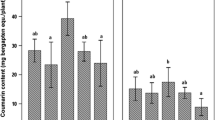Abstract
Extracts from mycorrhizal roots, non-mycorrhizal roots obtained from mycorrhizal root systems, and non-inoculated maize roots were fractionated by gel chromatography and their effects on the hyphal growth of arbuscular mycorrhizal fungusGlomus intraradices were studied under aseptic conditions. Low-molecular (MW lower than 3000) extracts obtained from mycorrhizal roots contained the fraction that most rapidly suppresses the hyphae growth. This was not observed for the fastest fraction obtained from non-mycorrhizal roots. The increased content of some inorganic ions, mainly potassium, was recorded in the fastest fraction of the mycorrhizal root extracts. At the same time, higher contents of two unidentified major organic compounds were revealed in this fraction of the mycorrhizal root extract compared to the non-mycorrhizal one. Some of these compounds, which are locally accumulated in the mycorrhizal parts of the root, are probably responsible for the effect observed. Potassium alone, even at a high concentration, cannot be responsible for the supression observed.
Similar content being viewed by others
References
Bécard G., Taylor L.P., Douds D.D., Pfeffer P.E. &Doner L.W. (1992): Extensive in vitro hyphal growth of vesicular-arbuscular mycorrhizal fungi in the presence of CO2 and flavonoids.Appl. Environm. Microbiol. 58:821–825.
Bécard G., Taylor L.P., Douds D.D., Pfeffer P.E. &Doner L.W. (1995): Flavonoids are not necessary plant signals in arbuscular mycorrhizal symbiosis.Molec. Pl.-Microbe Interact. 8: 252–258.
Domsch K.H., Gams W. &Anderson T.H. (1980):Compendium of soil fungi 1. Academic Press, London, New York, Toronto, Sydney, San Francisco.
Elias K.S. &Safir G.R. (1987): Hyphal elongation ofGlomus fasciculatus in response to root exudates.Appl. Environm. Microbiol. 53: 1928–1933.
Fester T., Maier W. &Strack D. (1999): Accumulation of secondary compounds in barley and wheat roots in response to inoculation with an arbuscular mycorrhizal fungus and co-inoculation with rhizosphere bacteria.Mycorrhiza 8: 241–246.
Gianinazzi-Pearson V., Branzanti B. &Gianinazzi S. (1989): In vitro enhancement of spore germination and early hyphal growth of a vesicular-arbuscular mycorrhizal fungus by host root exudates and plant flavonoids.Symbiosis 7: 243–255.
Gianinazzi-Pearson V. &Gianinazzi S. (1989): Cellular and genetical aspects of interactions between host and fungal symbionts in mycorrhizae.Genome 31: 336–341.
Giovannetti M. (1997): Host signals dictating growth direction, morphogenesis and differentiation in arbuscular mycorrhizal symbiosis. In:Schenk H.E.A, Herrmann R., Jeon K.W., Müller N.E. &Schwemmler W. (eds.),Eukaryotism and symbiosis, Springer, Berlin, Heidelberg, pp. 405–411.
Giovannetti M., Sbrana C. &Logi C. (1994): Early processes involved in host recognition by arbuscular mycorrhizal fungi.New Phytol. 127: 703–709.
Graham J.H. (1982): Effect of citrus root exudates on germination of chlamydospores of the vesicular-arbuscular mycorrhizal fungus,Glomus epigaeum.Mycologia 74: 831–835.
Gryndler M., Hršelová H., Chvátalová I. &Vosátka M. (1998): In vitro proliferation ofGlomus fistulosum intraradical hyphae from mycorrhizal root segments of maize.Mycol. Res. 102: 1067–1073.
Gryndler M., Vejsadová H. &Vančura V. (1992): The effect of magnesium ions on the vesicular-arbuscular mycorrhizal infection of maize roots.New Phytol. 122: 455–460.
Hepper C. M. &Mosse B. (1975): Techniques to study the interaction between Endogone and plant roots. In:Sanders F.E., Mosse B. &Tinker P.B. (eds.),Endomycorrhizas, Academic Press, London, pp. 65–75.
Klingner A., Bothe H., Wray V. &Marner F.-J. (1995): Identification of a yellow pigment formed in maize roots upon mycorrhizal colonization.Phytochemistry 38: 53–55.
Pinior A., Wyss U., Piché Y. &Vierheilig H. (1999): Plants colonized by AM fungi regulate further root colonization by AM fungi through altered root exudation.Canad. J. Bot. 77: 891–897.
Poulin M.-J., Simard J., Cartford J.-G., Labrie F. &Piché Y. (1997): Response of symbiotic endomycorrhizal fungi to estrogens and antiestrogens.Molec. Pl.-Microbe Interact. 10: 481–487.
Saito M. (1995): Enzyme activities of the external hyphae and germinated spores of an arbuscular mycorrhizal fungus,Gigaspora margarita Becker & Hall.New Phytol. 129: 425–431.
Schenck N.C. &Smith G.S. (1982): Additional new and unreported species of mycorrhizal fungi (Endogonaceae) from Florida.Mycologia 74: 77–92.
Schwab S.M. &Leonard R.T. (1984): Quantitative and qualitative comparison of root exudates of mycorrhizal and non-mycorrhizal plant species.Canad. J. Bot. 62: 1227–1231.
Schwab S.M., Menge J.A. &Leonard R.T. (1983): Quantitative and qualitative effects of phosphorus on extracts and exudates of sudangrass roots in relation to vesicular-arbuscular mycorrhiza formation.Pl. Physiol. 73: 761–765.
Shachar-Hill Y., Pfeffer P.E., Douds D., Osman S.F., Doner L.W. &Ratcliffe R.G. (1995): Partitioning of intermediary carbon metabolism in vesicular-arbuscular mycorrhizal leek.Pl. Physiol. 108: 7–15.
Turnau K. (1998): Heavy metal content and localization in mycorrhizalEuphoriba cyparissias from zinc wastes in southern Poland.Acta Soc. Bot. Poloniae 67: 105–113.
Vierheilig H., Alt-Hug M., Engel-Streitwolf R., Mäder P. &Wiemken A. (1998). Studies on the attractional effect of root exudates on hyphal growth of an arbuscular mycorrhizal fungus in a soil compartment-membrane system.Pl. & Soil 203: 137–144.
Author information
Authors and Affiliations
Corresponding author
Rights and permissions
About this article
Cite this article
Gryndler, M., Hršelová, H., Malcová, R. et al. Locally accumulated extractable compounds in mycorrhizal parts of maize roots suppress the growth ofHyphae ofGlomus intraradices . Folia Geobot 38, 125–138 (2003). https://doi.org/10.1007/BF02803145
Issue Date:
DOI: https://doi.org/10.1007/BF02803145




